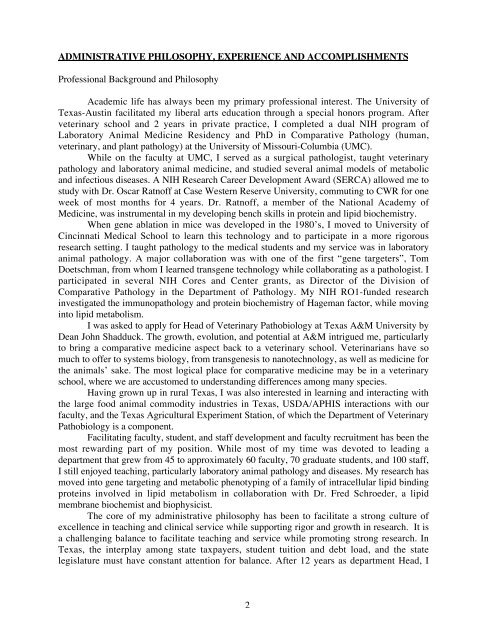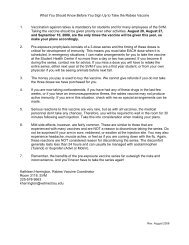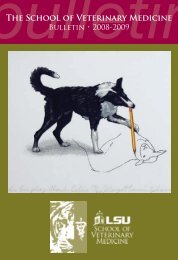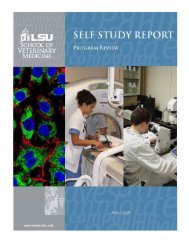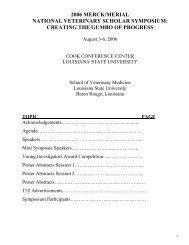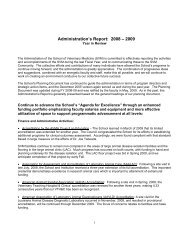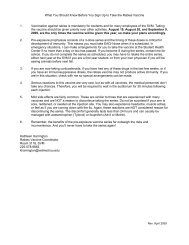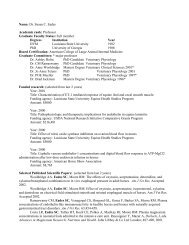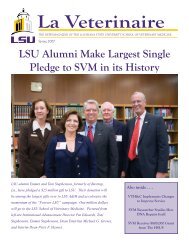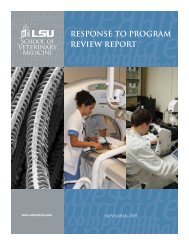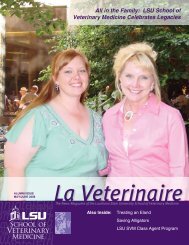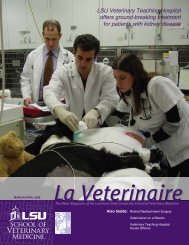curriculum vitae - School of Veterinary Medicine - Louisiana State ...
curriculum vitae - School of Veterinary Medicine - Louisiana State ...
curriculum vitae - School of Veterinary Medicine - Louisiana State ...
Create successful ePaper yourself
Turn your PDF publications into a flip-book with our unique Google optimized e-Paper software.
ADMINISTRATIVE PHILOSOPHY, EXPERIENCE AND ACCOMPLISHMENTSPr<strong>of</strong>essional Background and PhilosophyAcademic life has always been my primary pr<strong>of</strong>essional interest. The University <strong>of</strong>Texas-Austin facilitated my liberal arts education through a special honors program. Afterveterinary school and 2 years in private practice, I completed a dual NIH program <strong>of</strong>Laboratory Animal <strong>Medicine</strong> Residency and PhD in Comparative Pathology (human,veterinary, and plant pathology) at the University <strong>of</strong> Missouri-Columbia (UMC).While on the faculty at UMC, I served as a surgical pathologist, taught veterinarypathology and laboratory animal medicine, and studied several animal models <strong>of</strong> metabolicand infectious diseases. A NIH Research Career Development Award (SERCA) allowed me tostudy with Dr. Oscar Ratn<strong>of</strong>f at Case Western Reserve University, commuting to CWR for oneweek <strong>of</strong> most months for 4 years. Dr. Ratn<strong>of</strong>f, a member <strong>of</strong> the National Academy <strong>of</strong><strong>Medicine</strong>, was instrumental in my developing bench skills in protein and lipid biochemistry.When gene ablation in mice was developed in the 1980’s, I moved to University <strong>of</strong>Cincinnati Medical <strong>School</strong> to learn this technology and to participate in a more rigorousresearch setting. I taught pathology to the medical students and my service was in laboratoryanimal pathology. A major collaboration was with one <strong>of</strong> the first “gene targeters”, TomDoetschman, from whom I learned transgene technology while collaborating as a pathologist. Iparticipated in several NIH Cores and Center grants, as Director <strong>of</strong> the Division <strong>of</strong>Comparative Pathology in the Department <strong>of</strong> Pathology. My NIH RO1-funded researchinvestigated the immunopathology and protein biochemistry <strong>of</strong> Hageman factor, while movinginto lipid metabolism.I was asked to apply for Head <strong>of</strong> <strong>Veterinary</strong> Pathobiology at Texas A&M University byDean John Shadduck. The growth, evolution, and potential at A&M intrigued me, particularlyto bring a comparative medicine aspect back to a veterinary school. Veterinarians have somuch to <strong>of</strong>fer to systems biology, from transgenesis to nanotechnology, as well as medicine forthe animals’ sake. The most logical place for comparative medicine may be in a veterinaryschool, where we are accustomed to understanding differences among many species.Having grown up in rural Texas, I was also interested in learning and interacting withthe large food animal commodity industries in Texas, USDA/APHIS interactions with ourfaculty, and the Texas Agricultural Experiment Station, <strong>of</strong> which the Department <strong>of</strong> <strong>Veterinary</strong>Pathobiology is a component.Facilitating faculty, student, and staff development and faculty recruitment has been themost rewarding part <strong>of</strong> my position. While most <strong>of</strong> my time was devoted to leading adepartment that grew from 45 to approximately 60 faculty, 70 graduate students, and 100 staff,I still enjoyed teaching, particularly laboratory animal pathology and diseases. My research hasmoved into gene targeting and metabolic phenotyping <strong>of</strong> a family <strong>of</strong> intracellular lipid bindingproteins involved in lipid metabolism in collaboration with Dr. Fred Schroeder, a lipidmembrane biochemist and biophysicist.The core <strong>of</strong> my administrative philosophy has been to facilitate a strong culture <strong>of</strong>excellence in teaching and clinical service while supporting rigor and growth in research. It isa challenging balance to facilitate teaching and service while promoting strong research. InTexas, the interplay among state taxpayers, student tuition and debt load, and the statelegislature must have constant attention for balance. After 12 years as department Head, I2


